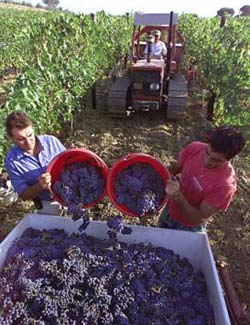How Wine is Made
 The
quality of a wine depends largely on the quality of the grapes used. The
goal of the production process is to maximize this quality.
The
quality of a wine depends largely on the quality of the grapes used. The
goal of the production process is to maximize this quality.
Wine
is produced through a biochemical process called fermentation, initiated by the
yeast added. During this process the sugar contained in the must (the fresh
grape juice) is transformed into alcohol along with the output of carbonic gases
that escape into the environment. Yeast is only able to fulfill its task between
-3°C and 36°C, and the wine maker can therefore regulate the temperature of
the steel vats according to their needs. Fermentation stops completely when the
sugar is completely transformed, but may also be stopped artificially. Enzymes
are destroyed over 65°C allowing for pasteurization. For finer wines this is
known as flash-pasteurization, which subjects the wine to temperatures up to 80°C
for thirty to sixty seconds.
One
needs to distinguish between red and white wine. In the production of red wine,
fermentation takes place at approximately 28°C and includes marc (grape skins,
stems and seeds). White wine is usually fermented at 18°C and without the marc.
The grape skins give the color to the wine. White wine can be made with red
grapes if the marc is removed before the color passes into the liquid.
Fermentation
and maturation can be completed in steel or oak containers. The advantages and
disadvantages for the two types are as follows:
|
|
Steel
vat |
Oak
Barrel |
|
|
Cost
for production |
Low |
High
(4x to 10x) |
|
|
Duration
of container |
Long |
Short |
|
|
Temperature
controllability |
High |
Low |
|
|
Respiratory
capacity of container |
No |
Yes |
|
|
Maintaining
the cleanliness of container |
Easy |
Difficult |
|
|
Vanillin
extract passed to wine |
No |
Yes |
|
|
Variation
of Tannin content of wine |
No |
Yes |
|
RED WINE
 After
the harvest that takes place in September or October, the grapes are crushed and
de-stemmed. Some stems remain since these contain vital tannins.
After
the harvest that takes place in September or October, the grapes are crushed and
de-stemmed. Some stems remain since these contain vital tannins.
The
fermentation then begins in a fermentation vat (casks or stainless-steel tank).
The grape skins tend to float at the top of the vat forming a cap or manta. To
mix the must with the skins it has to be pumped up from the bottom of the tank.
To control the fermentation the vats are held at a constant temperature of 28/30°C
and at this stage selected yeasts are added (the grapes already contain an
amount of natural yeast).
The
fermentation period lasts from a few days, for lighter wines and up to 30 days
for stronger wines. The longer the contact of the juice with the skins is
maintained, the stronger the color and tannin content of the wine becomes. This
can give the wine a fuller body and potentially a longer life span in the form
of age reachable. Too much tannin can, however, ruin a wine. At this point the
wine is separated from the skins and begins the aging process in barrels and
later bottles. After a period of fining in bottles it is sold on the market.
White
wine differs from red not only in terms of color. Traditionally they are
fermented without maceration, have lower tannin content, a lighter body, a
higher acidity and a shorter aging time compared to red wines. A white wine
usually has less alcohol but a greater fruit and floral characteristic. White
wines tend not to need decanting or opening before serving and are best served
at about 8° with lighter dishes.
The
fermentation process is usually more complex and involves a higher level of
technology. The grapes are crushed or pressed, immediately separating the skins.
After this the juice is cleansed and purged. Today the grapes are sometimes
crushed and macerated in a “vinimatic” for anything from
Fermentation
is usually at a temperature of about 18°C. Yeasts are often used when producing
white wine from red grapes because the contact with the skins is shorter and
therefore many natural yeasts are lost. Aging in barrels is not common but is
more commonly used today than in the past.
Rosè
wine can be produced by one of 3 methods: bleeding, pressing or limited
maceration. The latter is the most used and is exactly the same as the
vinification process of red wine, differing only in the maceration time. Rose
wine has a shorter maceration time.
In
the basic production of a sparkling wine, the carbonic gases produced by the
alcoholic fermentation are not allowed to escape but instead are dissolved into
the wine.
This
is usually produced from white wine where the grapes have been allowed to wilt.
This means that both the percentage of sugar and the amount of contact with
oxygen has been allowed to increase (due to the fact that the liquid tends to
decline). The wines produced tend to be gold or amber in color and are sweeter
than classical white wines.
MATURING
AND AGING
 White
wines are usually ready to be drunk the spring after the harvest. Nowadays, many
whites are aged for 6 to 18 month in barrels, to add more character and body to
the wine. Dessert wines, such as the Italian Vinsanto or Vino Santo may even be
aged up to 10 years before being sold.
White
wines are usually ready to be drunk the spring after the harvest. Nowadays, many
whites are aged for 6 to 18 month in barrels, to add more character and body to
the wine. Dessert wines, such as the Italian Vinsanto or Vino Santo may even be
aged up to 10 years before being sold.
Red wines usually benefit by aging in barrels, and in some cases a long maturing
phase is necessary to obtain the optimum wine. Wines suitable for aging tend to
have a minimum of 12% alcohol, have a higher content of acid and are rich in
tannins. For example the Italian Nebbiolo (used for Piedmont Barolo or
Barbaresco) has the characteristics suitable to undergo a long aging process. Not
all grape varieties produce a wine suited to aging. The optimal maturing period
changes from wine to wine and sometimes from harvest to harvest. It is very
important to age the wine in the best woods and in a correct cellar.
Temperatures should be between 10-15°c with humidity around 70%. The cellar
should be clean, dark, and aired.
In the past few years it has become very fashionable to use oak barrels in the
production of wine. These contain 225litres, and are also referred to as
barriques (often made from French forest oak wood). These barrels tend to last
up to 7 or 8 years but are often only used for just a couple of years before
being replaced. Wines suited best for the maturing in barrique are usually rich
in polyphenols such as Cabernet Sauvignon, Sangiovese, Merlot and Pinot Noir.

Information and tips for finding end enjoying everyday wines from Europe and other major wine regions:
Search the Blogs
Copyright WineNews.com 2009

